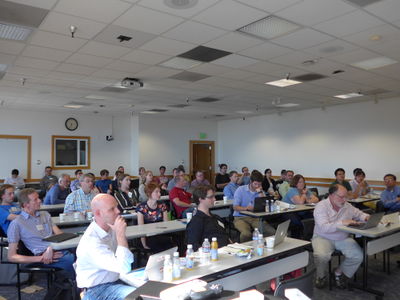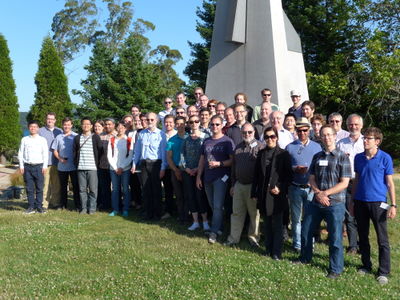canSAS-IX: Difference between revisions
No edit summary |
No edit summary |
||
| (10 intermediate revisions by 4 users not shown) | |||
| Line 3: | Line 3: | ||
__TOC__ | __TOC__ | ||
[[File:canSASIX EndOfDay1.JPG |400px|thumb|right]] | |||
== Summary == | |||
Over the course of the three days the participants heard from a number of speakers about the latest status on a variety of topics followed by some excellent smaller group discussions. At the end of the meeting during a wrap-up session some initial working groups and actions were agreed on while others will be worked on in follow ups from the individual breakout discussions. Some of the initial agreements were: | |||
* A strong sentiment being that the portal should be more widely known the attendees were all encouraged to add links to the portal from their websites, and/or signature file etc. | |||
* Paul Butler asked if anybody would be averse to being contacted for some of the large amount of content suggested for the portal during the 3 days. There was no dissent which was taken as a unanimous agreement. Paul suggested that he would start tackling that project in the fall and make contact with people starting in that time frame to start contributing. | |||
* A new working group was formed to work on the idea of a software repository and Adrian Rennie offered to host the first, face to face, meeting, in Uppsala. Volunteers included Andrew Jackson, Tom Caswell, Chris Tassone, Ron Pandolfi, Andrew McCluskey, Walter van Herck, and Tim Snow. Chris Tasonne circulated to collect additional names. | |||
* Another group was formed to work on creating a repository of example data with appropriate metadata. Alex agreed to kickoff that group with Kevin Yager from BNL (nominated in absentia) | |||
== Breakout Discussion == | |||
* [[Reliability | Reliability and Reproducibility]] | |||
* [[Information | Information, Education and Outreach]] | |||
* [[DataAnalysis | Data Analysis and Emerging Methods]] | |||
* [[ExperimentalTech | Experimental Technique Development]] | |||
[[File:Group_Photo_6June2017.JPG |400px|thumb|right]] | |||
== Goals == | == Goals == | ||
| Line 8: | Line 26: | ||
== Venue and Registration == | == Venue and Registration == | ||
=== Berkeley: Perseverance Hall - Building 54 Room 130 === | |||
=== Stanford: Building 48 Redwood Rooms === | |||
The first two days, June 5<sup>th</sup> and 6<sup>th</sup>, Will be held at the | The first two days, June 5<sup>th</sup> and 6<sup>th</sup>, Will be held at the LBNL in Perseverance Hall (bldg 54, room 130) while the final day, June 7<sup>th</sup> will be at SLAC. A hosted standing dinner/poster session will be held at the Lawrence Hall of Science on June 6<sup>th</sup> followed by arranged bus transportation of the attendees to Stanford. | ||
Note that as a "grass roots" community effort there are generally no specific funds to support the local organizing expenses of such meetings. Instead these expenses will be covered through mostly small registration fees asked of each participant. | Note that as a "grass roots" community effort there are generally no specific funds to support the local organizing expenses of such meetings. Instead these expenses will be covered through mostly small registration fees asked of each participant. | ||
| Line 45: | Line 65: | ||
** Instrument advances | ** Instrument advances | ||
* Information, Outreach and Education | * Information, Outreach and Education | ||
** Continued development of global SAS portal | ** What is lacking – what is feasible? | ||
** Development and maintain sas portal? How? What priorities? | |||
** Aggregating existing instructional materials? How? | |||
** Creating new instructional media? What and how? | |||
** Generating scientific case studies? How? | |||
** NXcanSAS standard – How to disseminate? What is next? | |||
OTHER? …. | |||
<!--** Continued development of global SAS portal | |||
** Aggregating instructional materials | ** Aggregating instructional materials | ||
** Generating scientific case studies | ** Generating scientific case studies | ||
** New Instructional media | ** New Instructional media | ||
** NXcanSAS standard for any-dimensional data. | ** NXcanSAS standard for any-dimensional data. | ||
--> | |||
==Speaker Slides== | |||
* [[media:canSASIX-KickOff.ppt | Butler - Intro slides]] | |||
* [[media:2017-06-05_Jemian_NXcanSAS.pdf | Jemian - NXcanSAS]] | |||
* [[media:Recent Developments in RheoSANS-for Wiki.pdf | Weigandt - RheoSANS]] | |||
==Local Organizing Committee == | ==Local Organizing Committee == | ||
Latest revision as of 01:40, 9 June 2017
ALS/SSRL Northern CA - June 5-7, 2017
Summary
Over the course of the three days the participants heard from a number of speakers about the latest status on a variety of topics followed by some excellent smaller group discussions. At the end of the meeting during a wrap-up session some initial working groups and actions were agreed on while others will be worked on in follow ups from the individual breakout discussions. Some of the initial agreements were:
- A strong sentiment being that the portal should be more widely known the attendees were all encouraged to add links to the portal from their websites, and/or signature file etc.
- Paul Butler asked if anybody would be averse to being contacted for some of the large amount of content suggested for the portal during the 3 days. There was no dissent which was taken as a unanimous agreement. Paul suggested that he would start tackling that project in the fall and make contact with people starting in that time frame to start contributing.
- A new working group was formed to work on the idea of a software repository and Adrian Rennie offered to host the first, face to face, meeting, in Uppsala. Volunteers included Andrew Jackson, Tom Caswell, Chris Tassone, Ron Pandolfi, Andrew McCluskey, Walter van Herck, and Tim Snow. Chris Tasonne circulated to collect additional names.
- Another group was formed to work on creating a repository of example data with appropriate metadata. Alex agreed to kickoff that group with Kevin Yager from BNL (nominated in absentia)
Breakout Discussion
- Reliability and Reproducibility
- Information, Education and Outreach
- Data Analysis and Emerging Methods
- Experimental Technique Development
Goals
The larger canSAS meetings are an opportunity for the community of SAS practitioners to come together as a whole, at a dedicated meeting, away from the distractions at other large meetings to discuss how issues have evolved since the last meeting and what the current challenges are for the community. In that spirit, the community is encouraged to participate early in shaping the content of the meeting by suggesting topics and speakers/discussion group leaders. The aim for this workshop then is to provide a forum for SAS users and providers to come together to discuss common needs and issues, to learn from each others experiences, discuss current best practices, hear about emerging techniques, and when possible to identify areas where the field/state of the art could be improved by bringing together the people that are interested and able to work cooperatively to solve the problem. Since the goal of the workshop is to foster discussion and collaborations on issues affecting the global SAS community (nomadic scatterers) besides participating in the discussion sessions, please consider submitting a poster. Posters are excellent ways to provide basic information that can then be used to seed or enhance discussions.
Venue and Registration
Berkeley: Perseverance Hall - Building 54 Room 130
Stanford: Building 48 Redwood Rooms
The first two days, June 5th and 6th, Will be held at the LBNL in Perseverance Hall (bldg 54, room 130) while the final day, June 7th will be at SLAC. A hosted standing dinner/poster session will be held at the Lawrence Hall of Science on June 6th followed by arranged bus transportation of the attendees to Stanford.
Note that as a "grass roots" community effort there are generally no specific funds to support the local organizing expenses of such meetings. Instead these expenses will be covered through mostly small registration fees asked of each participant.
Further details and registration can be made at the following web site:
https://sites.google.com/a/lbl.gov/cansas/home
Meeting Schedule and Topics
The lastest agenda is here
These meetings typically include a mix of plenary lectures on important topics, some plenary discussions, as well as several break out/parallel discussion sessions to discuss how we as a community might address specific issues.
The structure of the canSAS IX meeting is to dedicate a day to each topic though with 3 days and 4 topics, two topics will share Monday. The days will start with a short statement from the topic organizers setting the framework for the day followed by a series of hopefully thought provoking presentations related to the topic du jour. These will then be followed by a 1.5 to 2 hour breakout period in which the participants will divide into groups of 10 or less to brainstorm what they see as the current major issues related to the topic, what is needed to alleviate them and if possible propose possible paths forward to achieving real solutions. The day wraps up with a plenary discussion where the ideas generated in the various individual breakout teams can be shared including ideas/consensus on taking some action(s) gong forward.
The four topics being addressed at the canSAS IX meeting are:
- Data Analysis – Emerging Methods and Quality
- Automation
- New and evolving algorithms
- Coupling to simulation
- Modelling 2D data
- Collaborative funding strategies for SAS tools
- Reproducibility and Reliability
- Aggregating instrument parameters from SAS tools
- Aggregating scattering patterns from common standards
- New reference standards
- Sources of uncertainties and resolution
- Data handling for incoherent and inelastic scattering
- Experimental Technique Development
- Multimodal and time resolved characterization
- GISANS and GISAXS
- Variable contrast techniques (RSoXS, p-SAXS, SANS)
- Instrument advances
- Information, Outreach and Education
- What is lacking – what is feasible?
- Development and maintain sas portal? How? What priorities?
- Aggregating existing instructional materials? How?
- Creating new instructional media? What and how?
- Generating scientific case studies? How?
- NXcanSAS standard – How to disseminate? What is next?
OTHER? ….
Speaker Slides
Local Organizing Committee
- Alexander Hexemer (ALS)
- Christopher Tassone (SSRL)
- Cheng Wang (ALS)
- Chenhui Zhu (ALS)
- Hongping Yan (SSRL)
Program Committee
- Paul Butler (NIST, US)
- Masa Fukuto (NSLS II, US)
- Eva Herzig (TUM, Germany)
- Zhang Jiang (APS, US)
- Adrian Rennie (Uppsala University, Sweden)
- Sarah Rogers (STFC, England)
- Stephan Roth (PETRA III/DESY & KTH/Stockholm)
- Alessandro Sepe (Adolphe Merkle Inst., Switzerland)
- Gila Stein ( University of Tennessee, US)
- Jun-ichi Suzuki (CROSS Tokai, Japan)

